Corporate Financial Management: Capital Budgeting Techniques Analysis
VerifiedAdded on 2019/11/12
|10
|2546
|282
Report
AI Summary
This report delves into various capital budgeting techniques crucial for corporate financial management. It begins by explaining sensitivity analysis, a method used to assess the impact of changes in key variables on investment outcomes. The report then explores scenario analysis, which evaluates project viability under different economic and market conditions, considering optimistic, moderate, and conservative scenarios. Break-even analysis is also examined, highlighting how companies determine the sales level needed to cover costs and achieve profitability, with a focus on cost-volume-profit analysis. Finally, the report discusses simulation techniques, particularly the Monte Carlo approach, for modeling uncertainties in cash flows and aiding in investment appraisal. The report concludes by emphasizing the significance of these techniques in managing risk and making sound capital budgeting decisions, essential for the financial health and sustainable growth of a business enterprise. The references include the work of various authors in the field of finance and capital budgeting.

Corporate Financial Management
1 | P a g e
1 | P a g e
Paraphrase This Document
Need a fresh take? Get an instant paraphrase of this document with our AI Paraphraser

Table of Contents
Sensitivity analysis......................................................................................................................................3
Scenario Analysis........................................................................................................................................4
Break-Even Analysis...................................................................................................................................5
Simulation techniques.................................................................................................................................6
Conclusion...................................................................................................................................................8
2 | P a g e
Sensitivity analysis......................................................................................................................................3
Scenario Analysis........................................................................................................................................4
Break-Even Analysis...................................................................................................................................5
Simulation techniques.................................................................................................................................6
Conclusion...................................................................................................................................................8
2 | P a g e

Under the different tools and techniques of capital budgeting, the management of the company
considers the various capital outlays that it has under its proposals. The main exercise that is
involved in the overall process of capital budgeting is to correlate the various benefits that are to
be achieved over the period of time and consistency of performance that helps in maximizing the
overall objective of the business. Management has to analyze risk as a key function of financial
management. As it is generally seen that the long term investment decisions tend to be
complicated in nature, there exist a high vulnerability of external risk and uncertainty. As the
acquisition of business Assets and resources are the activities which are continuous and nature,
therefore management should utilise their expertise in order to evaluate correct and fair valuation
of business enterprise. In the current assignment, the analyst discussed over different concepts
that are in relation to utilisation of capital budgeting techniques and a business enterprise. Some
of them are discussed as follows -
Sensitivity analysis – Approach of investing in assets related to business are the major reasons
for growth and development of the business enterprise. The company with the objective of
achieving long term goals with timely approach must take efficient decision on the part of capital
investments. Growth and development of the business organization are not only achieved
through the purchase of new machinery and equipment but also expanding business operations
through developing new products and services. Before investing and placing money into a
project it is greatly required to understand and evaluate the associated risk, business strengths
and weaknesses (Жамойда & Мацюк, 2011). Though risk cannot be completely avoided, but it
should be minimised to acceptable business appetite. For this purpose management of the
business, the organization must conduct sensitivity analysis as a part of capital budgeting
technique in order to evaluate the possible risk and effectiveness of investment opportunities
(Bennouna, et. al., 2010).
Sensitivity analysis as a part of capital budgeting techniques supports the business managers to
evaluate the uncertain situations. As in a General scenario business activities are based on
forecasts which are determined on the basis of certain assumptions and estimates. The technique
of sensitivity analysis focuses on the part wherein the impact on the financial part of the
company is visualised while making changes in assumptions and business estimates. The tool of
3 | P a g e
considers the various capital outlays that it has under its proposals. The main exercise that is
involved in the overall process of capital budgeting is to correlate the various benefits that are to
be achieved over the period of time and consistency of performance that helps in maximizing the
overall objective of the business. Management has to analyze risk as a key function of financial
management. As it is generally seen that the long term investment decisions tend to be
complicated in nature, there exist a high vulnerability of external risk and uncertainty. As the
acquisition of business Assets and resources are the activities which are continuous and nature,
therefore management should utilise their expertise in order to evaluate correct and fair valuation
of business enterprise. In the current assignment, the analyst discussed over different concepts
that are in relation to utilisation of capital budgeting techniques and a business enterprise. Some
of them are discussed as follows -
Sensitivity analysis – Approach of investing in assets related to business are the major reasons
for growth and development of the business enterprise. The company with the objective of
achieving long term goals with timely approach must take efficient decision on the part of capital
investments. Growth and development of the business organization are not only achieved
through the purchase of new machinery and equipment but also expanding business operations
through developing new products and services. Before investing and placing money into a
project it is greatly required to understand and evaluate the associated risk, business strengths
and weaknesses (Жамойда & Мацюк, 2011). Though risk cannot be completely avoided, but it
should be minimised to acceptable business appetite. For this purpose management of the
business, the organization must conduct sensitivity analysis as a part of capital budgeting
technique in order to evaluate the possible risk and effectiveness of investment opportunities
(Bennouna, et. al., 2010).
Sensitivity analysis as a part of capital budgeting techniques supports the business managers to
evaluate the uncertain situations. As in a General scenario business activities are based on
forecasts which are determined on the basis of certain assumptions and estimates. The technique
of sensitivity analysis focuses on the part wherein the impact on the financial part of the
company is visualised while making changes in assumptions and business estimates. The tool of
3 | P a g e
⊘ This is a preview!⊘
Do you want full access?
Subscribe today to unlock all pages.

Trusted by 1+ million students worldwide
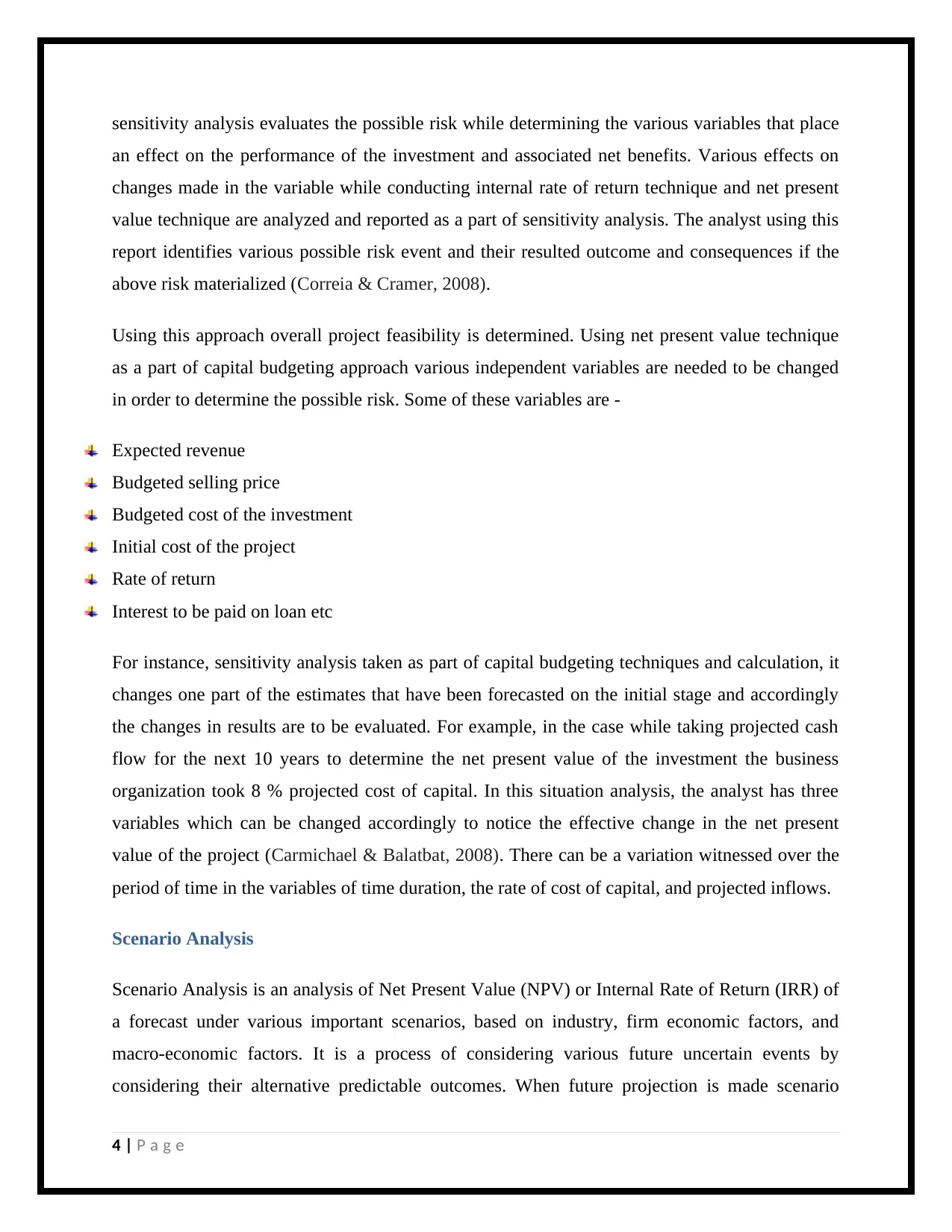
sensitivity analysis evaluates the possible risk while determining the various variables that place
an effect on the performance of the investment and associated net benefits. Various effects on
changes made in the variable while conducting internal rate of return technique and net present
value technique are analyzed and reported as a part of sensitivity analysis. The analyst using this
report identifies various possible risk event and their resulted outcome and consequences if the
above risk materialized (Correia & Cramer, 2008).
Using this approach overall project feasibility is determined. Using net present value technique
as a part of capital budgeting approach various independent variables are needed to be changed
in order to determine the possible risk. Some of these variables are -
Expected revenue
Budgeted selling price
Budgeted cost of the investment
Initial cost of the project
Rate of return
Interest to be paid on loan etc
For instance, sensitivity analysis taken as part of capital budgeting techniques and calculation, it
changes one part of the estimates that have been forecasted on the initial stage and accordingly
the changes in results are to be evaluated. For example, in the case while taking projected cash
flow for the next 10 years to determine the net present value of the investment the business
organization took 8 % projected cost of capital. In this situation analysis, the analyst has three
variables which can be changed accordingly to notice the effective change in the net present
value of the project (Carmichael & Balatbat, 2008). There can be a variation witnessed over the
period of time in the variables of time duration, the rate of cost of capital, and projected inflows.
Scenario Analysis
Scenario Analysis is an analysis of Net Present Value (NPV) or Internal Rate of Return (IRR) of
a forecast under various important scenarios, based on industry, firm economic factors, and
macro-economic factors. It is a process of considering various future uncertain events by
considering their alternative predictable outcomes. When future projection is made scenario
4 | P a g e
an effect on the performance of the investment and associated net benefits. Various effects on
changes made in the variable while conducting internal rate of return technique and net present
value technique are analyzed and reported as a part of sensitivity analysis. The analyst using this
report identifies various possible risk event and their resulted outcome and consequences if the
above risk materialized (Correia & Cramer, 2008).
Using this approach overall project feasibility is determined. Using net present value technique
as a part of capital budgeting approach various independent variables are needed to be changed
in order to determine the possible risk. Some of these variables are -
Expected revenue
Budgeted selling price
Budgeted cost of the investment
Initial cost of the project
Rate of return
Interest to be paid on loan etc
For instance, sensitivity analysis taken as part of capital budgeting techniques and calculation, it
changes one part of the estimates that have been forecasted on the initial stage and accordingly
the changes in results are to be evaluated. For example, in the case while taking projected cash
flow for the next 10 years to determine the net present value of the investment the business
organization took 8 % projected cost of capital. In this situation analysis, the analyst has three
variables which can be changed accordingly to notice the effective change in the net present
value of the project (Carmichael & Balatbat, 2008). There can be a variation witnessed over the
period of time in the variables of time duration, the rate of cost of capital, and projected inflows.
Scenario Analysis
Scenario Analysis is an analysis of Net Present Value (NPV) or Internal Rate of Return (IRR) of
a forecast under various important scenarios, based on industry, firm economic factors, and
macro-economic factors. It is a process of considering various future uncertain events by
considering their alternative predictable outcomes. When future projection is made scenario
4 | P a g e
Paraphrase This Document
Need a fresh take? Get an instant paraphrase of this document with our AI Paraphraser
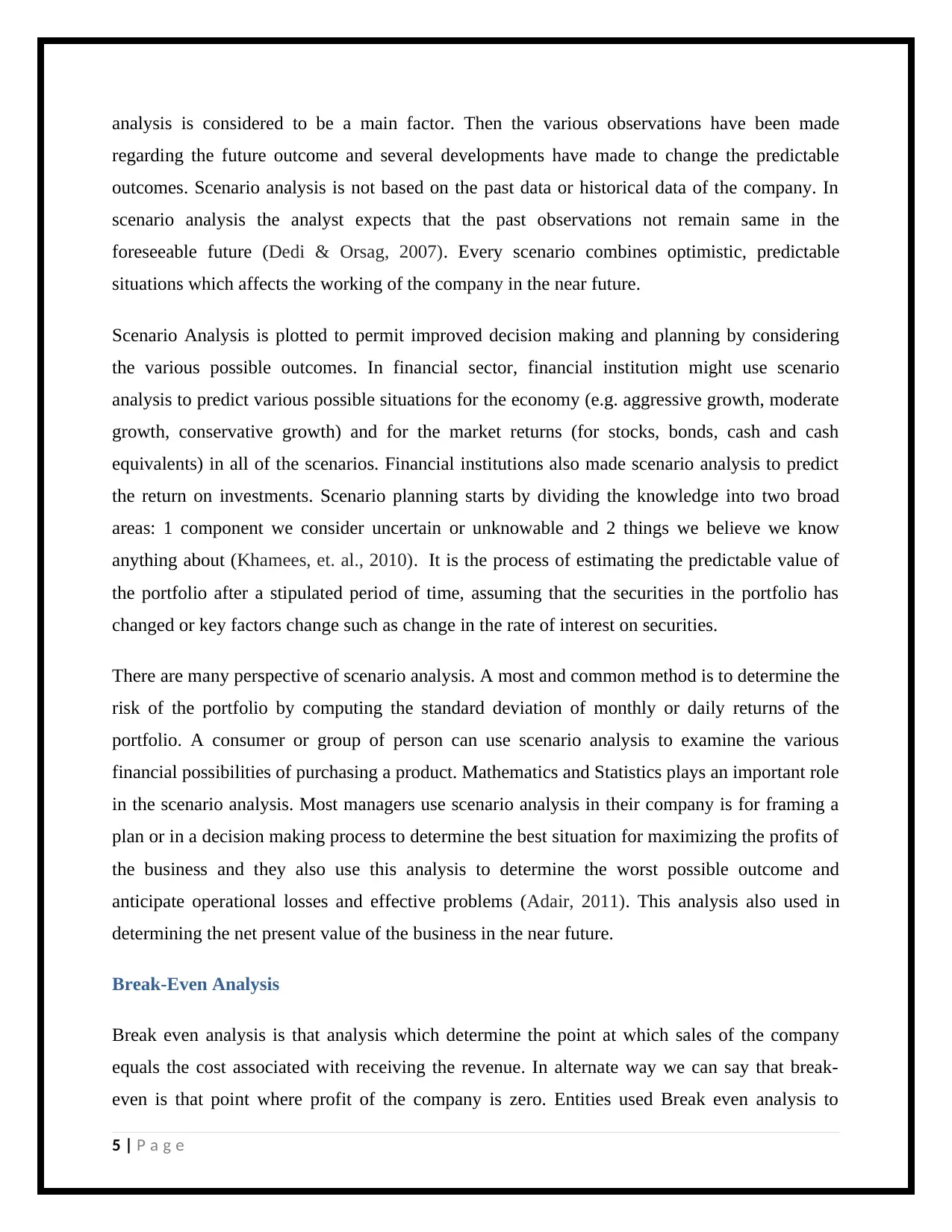
analysis is considered to be a main factor. Then the various observations have been made
regarding the future outcome and several developments have made to change the predictable
outcomes. Scenario analysis is not based on the past data or historical data of the company. In
scenario analysis the analyst expects that the past observations not remain same in the
foreseeable future (Dedi & Orsag, 2007). Every scenario combines optimistic, predictable
situations which affects the working of the company in the near future.
Scenario Analysis is plotted to permit improved decision making and planning by considering
the various possible outcomes. In financial sector, financial institution might use scenario
analysis to predict various possible situations for the economy (e.g. aggressive growth, moderate
growth, conservative growth) and for the market returns (for stocks, bonds, cash and cash
equivalents) in all of the scenarios. Financial institutions also made scenario analysis to predict
the return on investments. Scenario planning starts by dividing the knowledge into two broad
areas: 1 component we consider uncertain or unknowable and 2 things we believe we know
anything about (Khamees, et. al., 2010). It is the process of estimating the predictable value of
the portfolio after a stipulated period of time, assuming that the securities in the portfolio has
changed or key factors change such as change in the rate of interest on securities.
There are many perspective of scenario analysis. A most and common method is to determine the
risk of the portfolio by computing the standard deviation of monthly or daily returns of the
portfolio. A consumer or group of person can use scenario analysis to examine the various
financial possibilities of purchasing a product. Mathematics and Statistics plays an important role
in the scenario analysis. Most managers use scenario analysis in their company is for framing a
plan or in a decision making process to determine the best situation for maximizing the profits of
the business and they also use this analysis to determine the worst possible outcome and
anticipate operational losses and effective problems (Adair, 2011). This analysis also used in
determining the net present value of the business in the near future.
Break-Even Analysis
Break even analysis is that analysis which determine the point at which sales of the company
equals the cost associated with receiving the revenue. In alternate way we can say that break-
even is that point where profit of the company is zero. Entities used Break even analysis to
5 | P a g e
regarding the future outcome and several developments have made to change the predictable
outcomes. Scenario analysis is not based on the past data or historical data of the company. In
scenario analysis the analyst expects that the past observations not remain same in the
foreseeable future (Dedi & Orsag, 2007). Every scenario combines optimistic, predictable
situations which affects the working of the company in the near future.
Scenario Analysis is plotted to permit improved decision making and planning by considering
the various possible outcomes. In financial sector, financial institution might use scenario
analysis to predict various possible situations for the economy (e.g. aggressive growth, moderate
growth, conservative growth) and for the market returns (for stocks, bonds, cash and cash
equivalents) in all of the scenarios. Financial institutions also made scenario analysis to predict
the return on investments. Scenario planning starts by dividing the knowledge into two broad
areas: 1 component we consider uncertain or unknowable and 2 things we believe we know
anything about (Khamees, et. al., 2010). It is the process of estimating the predictable value of
the portfolio after a stipulated period of time, assuming that the securities in the portfolio has
changed or key factors change such as change in the rate of interest on securities.
There are many perspective of scenario analysis. A most and common method is to determine the
risk of the portfolio by computing the standard deviation of monthly or daily returns of the
portfolio. A consumer or group of person can use scenario analysis to examine the various
financial possibilities of purchasing a product. Mathematics and Statistics plays an important role
in the scenario analysis. Most managers use scenario analysis in their company is for framing a
plan or in a decision making process to determine the best situation for maximizing the profits of
the business and they also use this analysis to determine the worst possible outcome and
anticipate operational losses and effective problems (Adair, 2011). This analysis also used in
determining the net present value of the business in the near future.
Break-Even Analysis
Break even analysis is that analysis which determine the point at which sales of the company
equals the cost associated with receiving the revenue. In alternate way we can say that break-
even is that point where profit of the company is zero. Entities used Break even analysis to
5 | P a g e

determine the level of units which company has to sell in order to cover their total fixed costs.
Break even analysis concept deals with the contribution margin of the product. The contribution
is the difference between the sales and the total variable costs. And the contribution margin is the
difference of selling price and total variable cost per unit (Verma, et. al., 2009). Break even
analysis plays a vital role in determining the practical application of cost related functions. It
consist three factors, i.e sales volume, cost and profit. The aim of this analysis is to classify the
between sales volume and total costs of the company. It is also known as cost-volume-profit-
analysis. It helps in understanding the operating condition that exists when an entity ‘break-
even’. This is also known as no profit no loss point.
This analysis has very useful to the company and the executives of the company takes
forecasting decisions and make future planning by considering the break-even of the company.
In break-even analysis a break even chart has made by the managerial economists, company
executives and government agencies in order to find the break-even point. In the break even
chart total fixed cost, total revenue and total variable cost are shown separately (Bierman Jr &
Smidt, 2012). This break even chart shows the level of profit or loss to the entity at various levels
of activity.
In the situation of term loans, the institutions which have a business of finance have to find out
the possibility that the person who took the loan can repay the loan. In such case they had to find
the level of break-even point not only the total cost of the company are required but also the full
debt of the person. That level of break-even is called cash break-even. A firm has to decide the
most economical course of production both at planning level and expansion level. The break-
even analysis is the most helpful in determining the best course of action. For management, the
best use of break-even analysis is that they present a microscopic picture of the profit of the
company and it helps in determining the business model of the company. Despite some
limitations break even analysis has its own utility in managerial decision making. Considering
the above technique as a part of the management tool for the purpose of taking short term
decision it is considered highly worthwhile. Utilising this approach into current business
condition works out as an additional advantage for a business manager to incorporate the
fluctuations and changes that exist in the external micro environment due to its flexible
behaviour (James, et. al., 2010).
6 | P a g e
Break even analysis concept deals with the contribution margin of the product. The contribution
is the difference between the sales and the total variable costs. And the contribution margin is the
difference of selling price and total variable cost per unit (Verma, et. al., 2009). Break even
analysis plays a vital role in determining the practical application of cost related functions. It
consist three factors, i.e sales volume, cost and profit. The aim of this analysis is to classify the
between sales volume and total costs of the company. It is also known as cost-volume-profit-
analysis. It helps in understanding the operating condition that exists when an entity ‘break-
even’. This is also known as no profit no loss point.
This analysis has very useful to the company and the executives of the company takes
forecasting decisions and make future planning by considering the break-even of the company.
In break-even analysis a break even chart has made by the managerial economists, company
executives and government agencies in order to find the break-even point. In the break even
chart total fixed cost, total revenue and total variable cost are shown separately (Bierman Jr &
Smidt, 2012). This break even chart shows the level of profit or loss to the entity at various levels
of activity.
In the situation of term loans, the institutions which have a business of finance have to find out
the possibility that the person who took the loan can repay the loan. In such case they had to find
the level of break-even point not only the total cost of the company are required but also the full
debt of the person. That level of break-even is called cash break-even. A firm has to decide the
most economical course of production both at planning level and expansion level. The break-
even analysis is the most helpful in determining the best course of action. For management, the
best use of break-even analysis is that they present a microscopic picture of the profit of the
company and it helps in determining the business model of the company. Despite some
limitations break even analysis has its own utility in managerial decision making. Considering
the above technique as a part of the management tool for the purpose of taking short term
decision it is considered highly worthwhile. Utilising this approach into current business
condition works out as an additional advantage for a business manager to incorporate the
fluctuations and changes that exist in the external micro environment due to its flexible
behaviour (James, et. al., 2010).
6 | P a g e
⊘ This is a preview!⊘
Do you want full access?
Subscribe today to unlock all pages.

Trusted by 1+ million students worldwide
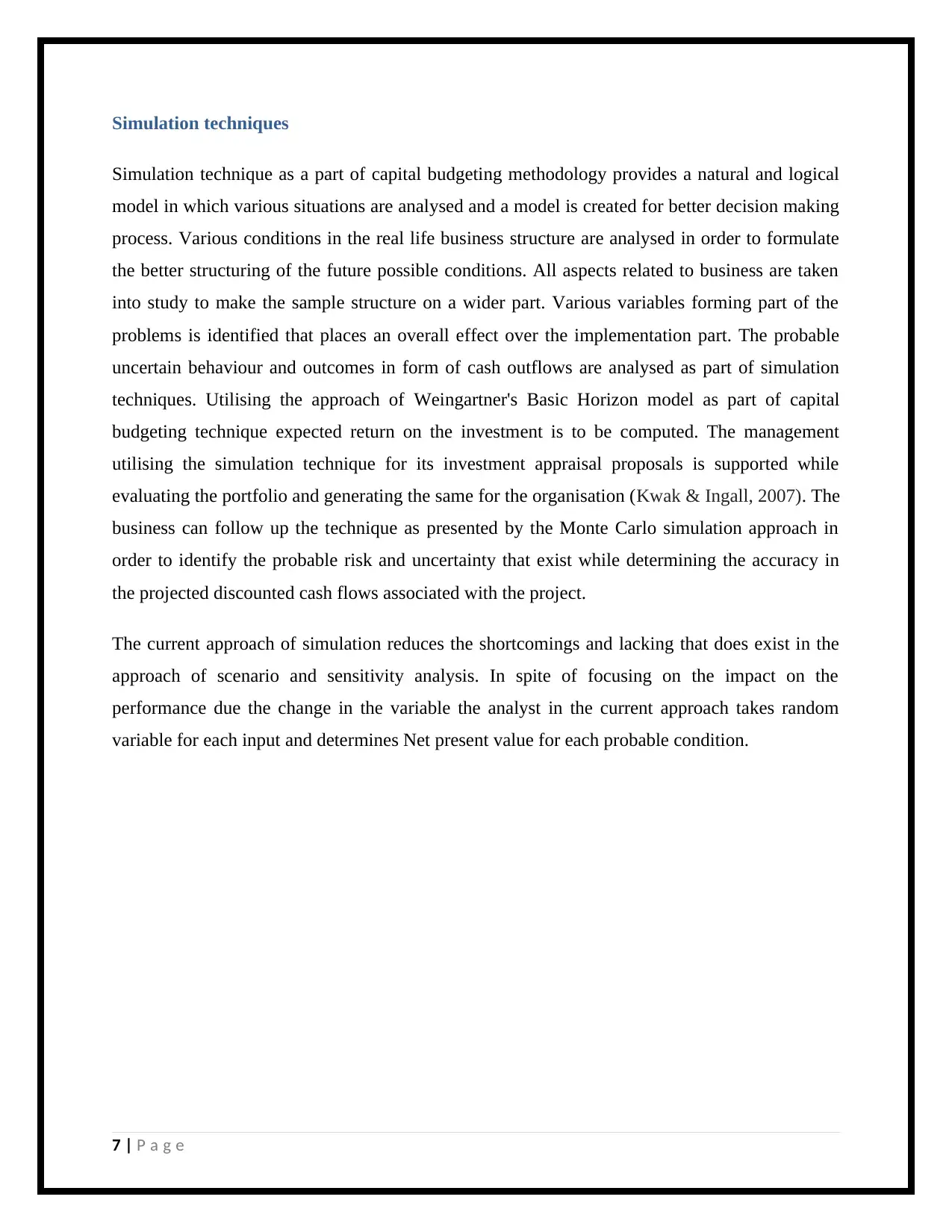
Simulation techniques
Simulation technique as a part of capital budgeting methodology provides a natural and logical
model in which various situations are analysed and a model is created for better decision making
process. Various conditions in the real life business structure are analysed in order to formulate
the better structuring of the future possible conditions. All aspects related to business are taken
into study to make the sample structure on a wider part. Various variables forming part of the
problems is identified that places an overall effect over the implementation part. The probable
uncertain behaviour and outcomes in form of cash outflows are analysed as part of simulation
techniques. Utilising the approach of Weingartner's Basic Horizon model as part of capital
budgeting technique expected return on the investment is to be computed. The management
utilising the simulation technique for its investment appraisal proposals is supported while
evaluating the portfolio and generating the same for the organisation (Kwak & Ingall, 2007). The
business can follow up the technique as presented by the Monte Carlo simulation approach in
order to identify the probable risk and uncertainty that exist while determining the accuracy in
the projected discounted cash flows associated with the project.
The current approach of simulation reduces the shortcomings and lacking that does exist in the
approach of scenario and sensitivity analysis. In spite of focusing on the impact on the
performance due the change in the variable the analyst in the current approach takes random
variable for each input and determines Net present value for each probable condition.
7 | P a g e
Simulation technique as a part of capital budgeting methodology provides a natural and logical
model in which various situations are analysed and a model is created for better decision making
process. Various conditions in the real life business structure are analysed in order to formulate
the better structuring of the future possible conditions. All aspects related to business are taken
into study to make the sample structure on a wider part. Various variables forming part of the
problems is identified that places an overall effect over the implementation part. The probable
uncertain behaviour and outcomes in form of cash outflows are analysed as part of simulation
techniques. Utilising the approach of Weingartner's Basic Horizon model as part of capital
budgeting technique expected return on the investment is to be computed. The management
utilising the simulation technique for its investment appraisal proposals is supported while
evaluating the portfolio and generating the same for the organisation (Kwak & Ingall, 2007). The
business can follow up the technique as presented by the Monte Carlo simulation approach in
order to identify the probable risk and uncertainty that exist while determining the accuracy in
the projected discounted cash flows associated with the project.
The current approach of simulation reduces the shortcomings and lacking that does exist in the
approach of scenario and sensitivity analysis. In spite of focusing on the impact on the
performance due the change in the variable the analyst in the current approach takes random
variable for each input and determines Net present value for each probable condition.
7 | P a g e
Paraphrase This Document
Need a fresh take? Get an instant paraphrase of this document with our AI Paraphraser
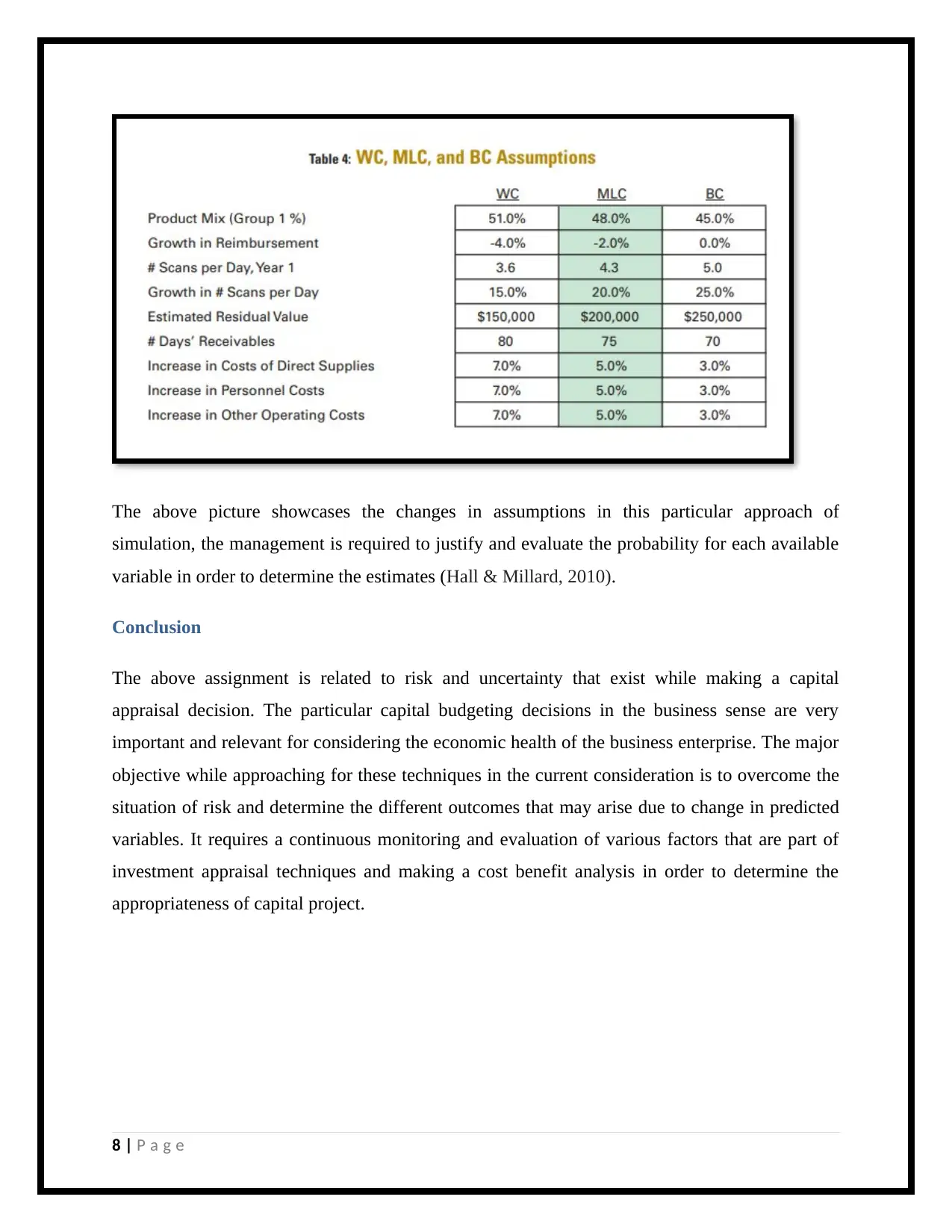
The above picture showcases the changes in assumptions in this particular approach of
simulation, the management is required to justify and evaluate the probability for each available
variable in order to determine the estimates (Hall & Millard, 2010).
Conclusion
The above assignment is related to risk and uncertainty that exist while making a capital
appraisal decision. The particular capital budgeting decisions in the business sense are very
important and relevant for considering the economic health of the business enterprise. The major
objective while approaching for these techniques in the current consideration is to overcome the
situation of risk and determine the different outcomes that may arise due to change in predicted
variables. It requires a continuous monitoring and evaluation of various factors that are part of
investment appraisal techniques and making a cost benefit analysis in order to determine the
appropriateness of capital project.
8 | P a g e
simulation, the management is required to justify and evaluate the probability for each available
variable in order to determine the estimates (Hall & Millard, 2010).
Conclusion
The above assignment is related to risk and uncertainty that exist while making a capital
appraisal decision. The particular capital budgeting decisions in the business sense are very
important and relevant for considering the economic health of the business enterprise. The major
objective while approaching for these techniques in the current consideration is to overcome the
situation of risk and determine the different outcomes that may arise due to change in predicted
variables. It requires a continuous monitoring and evaluation of various factors that are part of
investment appraisal techniques and making a cost benefit analysis in order to determine the
appropriateness of capital project.
8 | P a g e
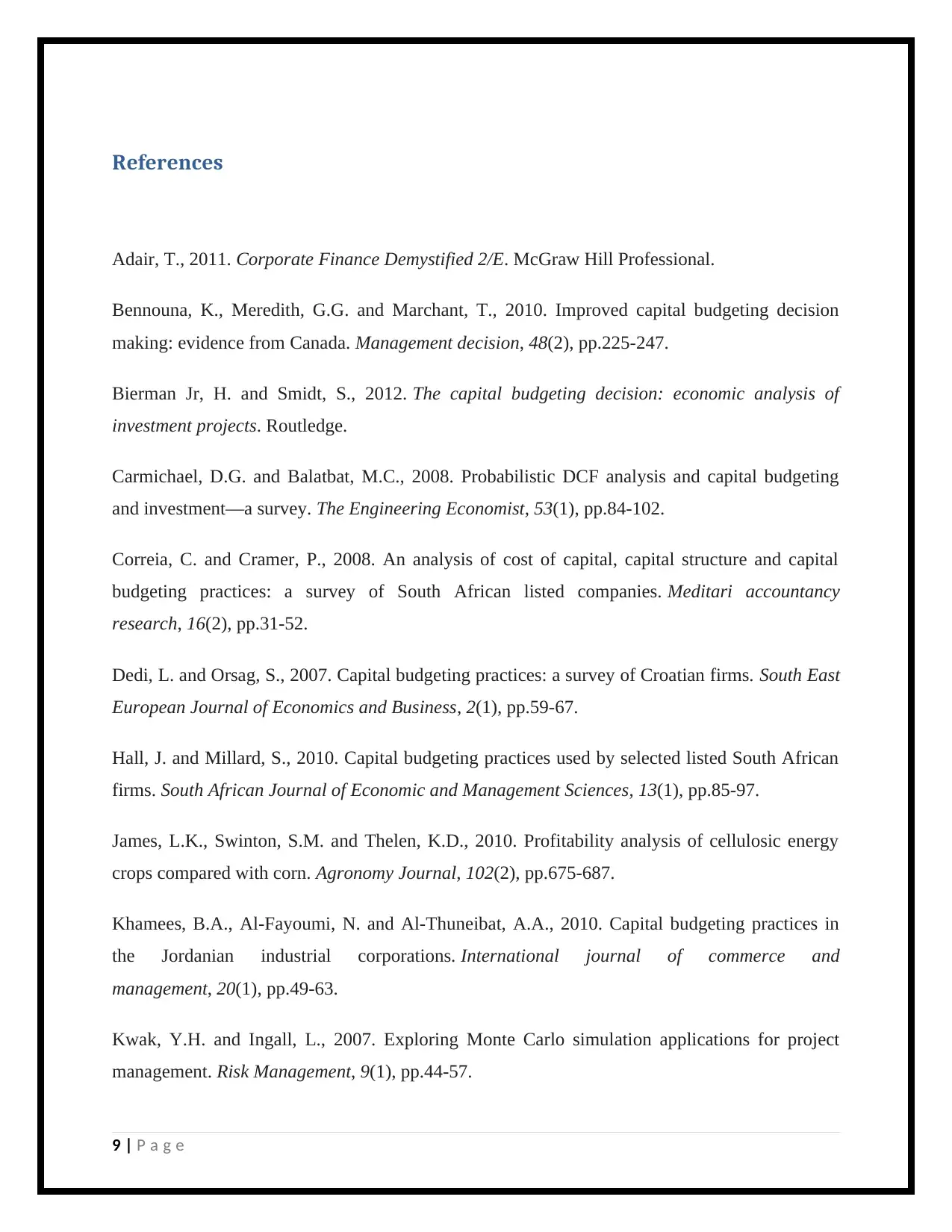
References
Adair, T., 2011. Corporate Finance Demystified 2/E. McGraw Hill Professional.
Bennouna, K., Meredith, G.G. and Marchant, T., 2010. Improved capital budgeting decision
making: evidence from Canada. Management decision, 48(2), pp.225-247.
Bierman Jr, H. and Smidt, S., 2012. The capital budgeting decision: economic analysis of
investment projects. Routledge.
Carmichael, D.G. and Balatbat, M.C., 2008. Probabilistic DCF analysis and capital budgeting
and investment—a survey. The Engineering Economist, 53(1), pp.84-102.
Correia, C. and Cramer, P., 2008. An analysis of cost of capital, capital structure and capital
budgeting practices: a survey of South African listed companies. Meditari accountancy
research, 16(2), pp.31-52.
Dedi, L. and Orsag, S., 2007. Capital budgeting practices: a survey of Croatian firms. South East
European Journal of Economics and Business, 2(1), pp.59-67.
Hall, J. and Millard, S., 2010. Capital budgeting practices used by selected listed South African
firms. South African Journal of Economic and Management Sciences, 13(1), pp.85-97.
James, L.K., Swinton, S.M. and Thelen, K.D., 2010. Profitability analysis of cellulosic energy
crops compared with corn. Agronomy Journal, 102(2), pp.675-687.
Khamees, B.A., Al-Fayoumi, N. and Al-Thuneibat, A.A., 2010. Capital budgeting practices in
the Jordanian industrial corporations. International journal of commerce and
management, 20(1), pp.49-63.
Kwak, Y.H. and Ingall, L., 2007. Exploring Monte Carlo simulation applications for project
management. Risk Management, 9(1), pp.44-57.
9 | P a g e
Adair, T., 2011. Corporate Finance Demystified 2/E. McGraw Hill Professional.
Bennouna, K., Meredith, G.G. and Marchant, T., 2010. Improved capital budgeting decision
making: evidence from Canada. Management decision, 48(2), pp.225-247.
Bierman Jr, H. and Smidt, S., 2012. The capital budgeting decision: economic analysis of
investment projects. Routledge.
Carmichael, D.G. and Balatbat, M.C., 2008. Probabilistic DCF analysis and capital budgeting
and investment—a survey. The Engineering Economist, 53(1), pp.84-102.
Correia, C. and Cramer, P., 2008. An analysis of cost of capital, capital structure and capital
budgeting practices: a survey of South African listed companies. Meditari accountancy
research, 16(2), pp.31-52.
Dedi, L. and Orsag, S., 2007. Capital budgeting practices: a survey of Croatian firms. South East
European Journal of Economics and Business, 2(1), pp.59-67.
Hall, J. and Millard, S., 2010. Capital budgeting practices used by selected listed South African
firms. South African Journal of Economic and Management Sciences, 13(1), pp.85-97.
James, L.K., Swinton, S.M. and Thelen, K.D., 2010. Profitability analysis of cellulosic energy
crops compared with corn. Agronomy Journal, 102(2), pp.675-687.
Khamees, B.A., Al-Fayoumi, N. and Al-Thuneibat, A.A., 2010. Capital budgeting practices in
the Jordanian industrial corporations. International journal of commerce and
management, 20(1), pp.49-63.
Kwak, Y.H. and Ingall, L., 2007. Exploring Monte Carlo simulation applications for project
management. Risk Management, 9(1), pp.44-57.
9 | P a g e
⊘ This is a preview!⊘
Do you want full access?
Subscribe today to unlock all pages.

Trusted by 1+ million students worldwide

Verma, S., Gupta, S. and Batra, R., 2009. A survey of capital budgeting practices in corporate
India. Vision, 13(3), pp.1-17.
Жамойда, О.А. and Мацюк, М.С., 2011. Sensitivity Analysis in Capital Budgeting.
10 | P a g e
India. Vision, 13(3), pp.1-17.
Жамойда, О.А. and Мацюк, М.С., 2011. Sensitivity Analysis in Capital Budgeting.
10 | P a g e
1 out of 10
Related Documents
Your All-in-One AI-Powered Toolkit for Academic Success.
+13062052269
info@desklib.com
Available 24*7 on WhatsApp / Email
![[object Object]](/_next/static/media/star-bottom.7253800d.svg)
Unlock your academic potential
Copyright © 2020–2025 A2Z Services. All Rights Reserved. Developed and managed by ZUCOL.





